¿Qué es el Control Total de Calidad? de Kaoru Ishikawa

Contenido
Capítulo 1
Mi encuentro con el control de calidad
Capítulo 2
Características del control de calidad japonés
Capítulo 3
La esencia del control de calidad
Capítulo 4
La garantía de la calidad
Capítulo 5
El control total de la calidad
Capítulo 6
El CTC es una revolución conceptual en la gerencia
Capítulo 7
¿Qué hacer y qué no hacer en la gerencia alta y media?
Capítulo 8
Actividades de los círculos de CC
Capítulo 9
Control de calidad para subcontratos y compras
Capítulo 10
Control de calidad en el mercadeo: industrias de distribución y servicios
Capítulo 11
Auditoría de control de calidad
Capítulo 12
Utilización de métodos estadísticos
The Synthetic Organic by MICHAEL C. PIRRUNG

Contents
Chapter 1
Searching The Literature
Chapter 2
Reagents
Chapter 3
Gases
Chapter 4
Reactions on a Small Scale: 1 to 25 mmol
Chapter 5
Temperature Control
Chapter 6
Solvents
Chapter 7
The Research Notebook
Chapter 8
Conducting the Reaction Itself
Chapter 9
Following the Reaction
Chapter 10
Working up Reactions
Chapter 11
Evaporation
Chapter 12
Vacuum Systems
Chapter 13
Purification of Products
Chapter 14
Methods for Structure Elucidation
Chapter 15
Cleaning up after the Reaction
Chapter 16
Specific Examples
Chapter 17
Strategies for Reaction Optimización
The Biodiesel Handbook by G. Knothe, J. V. Gerpen and J. Krahl

Contents
1 Introduction
Gerhard Knothe
2 The History of Vegetable Oil-Based Diesel Fuels
Gerhard Knothe
3 The Basics of Diesel Engines and Diesel Fuels
Jon Van Gerpen
4 Biodiesel Production
4.1 Basics of the Transesterification Reaction
Jon Van Gerpen and Gerhard Knothe
4.2 Alternate Feedstocks and Technologies for Biodiesel Production
Michael J. Haas and Thomas A. Foglia
5 Analytical Methods for Biodiesel
Gerhard Knothe
6 Fuel Properties
Gerhard Knothe
6.1 Cetane Numbers–Heat of Combustion–Why Vegetable
Oils and Their Derivatives Are Suitable as a Diesel Fuel
Gerhard Knothe
6.2 Viscosity of Biodiesel
Gerhard Knothe
6.3 Cold Weather Properties and Performance of Biodiesel
Robert O. Dunn
6.4 Oxidative Stability of Biodiesel
6.4.1 Literature Overview
Gerhard Knothe
6.4.2 Stability of Biodiesel
Heinrich Prankl
6.5 Biodiesel Lubricity
Leon Schumacher
6.6 Biodiesel Fuels: Biodegradability, Biological and Chemical Oxygen
Demand, and Toxicity
C.L. Peterson and Gregory Möller
6.7 Soybean Oil Composition for Biodiesel
Neal A. Bringe
7 Exhaust Emissions
7.1 Effect of Biodiesel Fuel on Pollutant Emissions
from Diesel Engines
Robert L. McCormick and Teresa L. Alleman
7.2 Influence of Biodiesel and Different Petrodiesel Fuels
on Exhaust Emissions and Health Effects
Jürgen Krahl, Axel Munack, Olaf Schröder, Hendrik Stein,
and Jürgen Bünger
8 Current Status of the Biodiesel Industry
8.1 Current Status of Biodiesel in the United States
Steve Howell and Joe Jobe
8.2 Current Status of Biodiesel in the European Union
Dieter Bockey
8.2.1 Biodiesel Quality Management: The AGQM Story
Jürgen Fischer
8.3 Status of Biodiesel in Asia, the Americas, Australia,
and South Africa
Werner Körbitz
8.4 Environmental Implications of Biodiesel (Life-Cycle
Assessment)
Sven O. Gärtner and Guido A. Reinhardt
8.5 Potential Production of Biodiesel
Charles L. Peterson
9 Other Uses of Biodiesel
Gerhard Knothe
10 Other Alternative Diesel Fuels from Vegetable Oils
Robert O. Dunn
11 Glycerol
Donald B. Appleby
Appendix A: Technical Tables
Appendix B: Biodiesel Standards
Appendix C: Internet Resources
Vitamins, Minerals and Supplements by Tova Navarra, B.A., R.N.

Overall, the findings from the new American Dietetic Association survey of Americans’ beliefs about nutrition show that some nutritional information is reaching the public, but not all of it, and not everybody is listening, a panel of experts said here on October 20, 2002.
Quality Management Demystified by Sid Kemp PMP
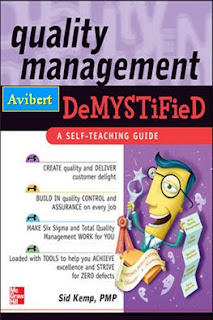
PART ONE: MANAGING QUALITY
CHAPTER 1
Quality Throughout History
CHAPTER 2
The Development of Quality Management
CHAPTER 3
Defining Quality
CHAPTER 4
Quality for the Customer
PART TWO: QUALITY ESSENTIALS
CHAPTER 5
Key Quality Concepts
CHAPTER 6
Defining, Planning for, Controlling, Assuring, and Delivering Quality
CHAPTER 7
Leading a Quality Team
CHAPTER 8
Quality Engineering
CHAPTER 9
Auditing Quality
CHAPTER 10
Statistics for Quality
PART THREE: QUALITY MOVEMENTS
CHAPTER 11
Total Quality Management
CHAPTER 12
Quality Standards—ISO 9000 and More
CHAPTER 13
Six Sigma
CHAPTER 14
The Cost of Quality
CHAPTER 15
The Capability for Quality: CMM and CMMI
CHAPTER 16
Steady Improvement in Japan: Gemba Kaizen for Lean (JIT) Manufacturing
PART FOUR: PRACTICAL QUALITY MANAGEMENT
CHAPTER 17
Challenges and Leadership
CHAPTER 18
Practical Quality for Projects and Programs
CHAPTER 19
Global Quality in the 21st Century
Conduction in Porous Media Examples of Conduction in Porous Media
The idea is to provide intimate contact between the coolant and the material to be cooled. Thus heat transfer in porous media is a volumetric process rather than surface action.
Fig. 5.1 illustrates several examples of conduction in porous media. In Fig. 5.1a, a porous ring is placed at the throat of a rocket nozzle to protect it from high temperature damage. Air or helium is injected through the porous ring to provide an efficient cooling mechanism. Fig. 5.1b shows a porous heat shield designed to protect a space vehicle during atmospheric entry.
Cooling of porous turbine blades is shown in Fig. 5.1c . Transpiration cooling has been proposed as an efficient method for protecting microelectronic components. Fig. 5.1d represents an electronic device with a microchannel sink. Coolant flow through the channels provides effective thermal protection. Fig. 5.1e shows a porous fireman’s suit for use in a hot environment. Other examples include heat transfer in blood-perfused tissue and geothermal applications.
Reference: Heat Conduction
Introductory Economics by Arleen J. Hoag and John H. Hoag
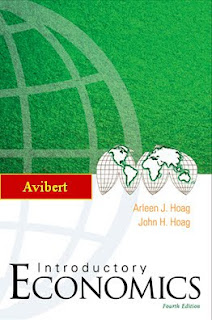
Brief Outline
Module 1 The Economic Problem
Chapter 1 The Meaning of Economics
Chapter 2 Methods
Chapter 3 Production Possibilities
Chapter 4 Economic Systems
Module 2 Price Determination
Chapter 5 Demand
Chapter 6 Supply
Chapter 7 Market Equilibrium
Chapter 8 Price Elasticity
Module 3 Behind the Supply Curve
Chapter 9 Diminishing Returns
Chapter 10 Cost
Chapter 11 Revenue
Chapter 12 Profit
Chapter 13 Perfectly Competitive Supply
Chapter 14 Monopoly
Chapter 15 Imperfect Competition
Chapter 16 Demand for Inputs
Module 4 Measuring the Economy
Chapter 17 Unemployment and Inflation
Chapter 18 Gross Domestic Product
Chapter 19 Price Indexes
Chapter 20 Business Cycles
Module 5 The Level of Income
Chapter 21 Consumption and Investment
Chapter 22 Macro Equilibrium
Chapter 23 Government
Chapter 24 The Keynesian Cross
Chapter 25 Fiscal Policy
Module 6 Money
Chapter 26 Money
Chapter 27 Monetary Tools
Chapter 28 Money and the Level of Income
Chapter 29 Economic Policy
Module 7 Trade
Chapter 30 Trade without Money
Chapter 31 Trade with Money
Module 8 Conclusion
Glossary
Index
Controlling the Flow Properties
of Liquid Chocolate
 The flow properties of liquid chocolate are important to the consumer and the confectionery manufacturer. Although there are many very sophisticated instruments for measuring viscosity and texture, the human mouth is really far more sensitive than most of these. When someone eats chocolate, the teeth bite through the solid chocolate. This means that the hardness of the solid chocolate is very important. The temperature of the mouth, at about 37 1C, is above the melting point of the fat within the chocolate, so it rapidly melts, especially as it is subjected to the intense mixing and shearing of the teeth and tongue. Once it has melted there are two important factors. One is the maximum particle size. As was noted earlier, if there is a significant number of particles larger than 30 microns (0.03mm) the chocolate will feel gritty on the tongue. In addition, for sizes below 30 micron a difference of 2–3 microns in maximum particle size can be detected as different levels of smoothness. Chocolates with a maximum particle size of about 20 microns have been sold as having a silky texture. The second factor is the viscosity. This not only affects the way the chocolate runs around the mouth, i.e. the texture, but it also changes the taste. This is because the mouth contains three different flavour receptors in different places (see Figure 5.1). The time the solid particles in the chocolate take to reach the receptors depends on the viscosity. This means that two chocolates made from identical ingredients, but processed to give different viscosities, will taste very different. (See Project 15 in Chapter 12). Particle size affects viscosity as well as texture, and a milk chocolate which has been milled to say a maximum particle size of 20 microns will have a creamier taste and texture than one of 30 microns.
The flow properties of liquid chocolate are important to the consumer and the confectionery manufacturer. Although there are many very sophisticated instruments for measuring viscosity and texture, the human mouth is really far more sensitive than most of these. When someone eats chocolate, the teeth bite through the solid chocolate. This means that the hardness of the solid chocolate is very important. The temperature of the mouth, at about 37 1C, is above the melting point of the fat within the chocolate, so it rapidly melts, especially as it is subjected to the intense mixing and shearing of the teeth and tongue. Once it has melted there are two important factors. One is the maximum particle size. As was noted earlier, if there is a significant number of particles larger than 30 microns (0.03mm) the chocolate will feel gritty on the tongue. In addition, for sizes below 30 micron a difference of 2–3 microns in maximum particle size can be detected as different levels of smoothness. Chocolates with a maximum particle size of about 20 microns have been sold as having a silky texture. The second factor is the viscosity. This not only affects the way the chocolate runs around the mouth, i.e. the texture, but it also changes the taste. This is because the mouth contains three different flavour receptors in different places (see Figure 5.1). The time the solid particles in the chocolate take to reach the receptors depends on the viscosity. This means that two chocolates made from identical ingredients, but processed to give different viscosities, will taste very different. (See Project 15 in Chapter 12). Particle size affects viscosity as well as texture, and a milk chocolate which has been milled to say a maximum particle size of 20 microns will have a creamier taste and texture than one of 30 microns.For the manufacturer, the weight control of the products is very important. Chocolate is a relatively expensive food in terms of both ingredients and processing. It is therefore economically important not to put too much chocolate on a confectionery centre. As will be shown in Chapter 7, the coating methods rely on the liquid chocolate having the correct viscosity. In addition, if the coating is not put on correctly, misshapes will be formed (see Figures 4.2 and 4.3), or the centre will be exposed reducing the shelf life of the product.
Reference: The Science of Chocolate
Wine A Scientific Exploration
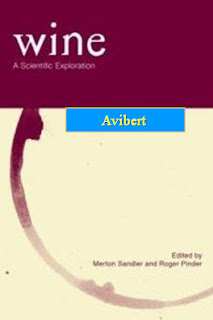
Contents
Chapter 1
Drinking wine
R. GEORGE
Chapter 2
The history of wine as a medicine
P. A. NORRIE
Chapter 3
Archaeology and the origins of wine production
J. M. RENFREW
Chapter 4
Saving the vine from Phylloxera: a never-ending battle
G. GALE
Chapter 5
Wine and heart disease: a statistical approach
M. BOBAK AND M. MARMOT
Chapter 6
Wine, alcohol and cardiovascular diseases
A. L. KLATSKY
Chapter 7
Wine flavonoids, LDL cholesterol oxidation and atherosclerosis
M. AVIRAM AND B. FUHRMAN
Chapter 8
Resveratrol: biochemistry, cell biology and the potential role in disease prevention
D. M. GOLDBERG AND G. J. SOLEAS
Chapter 9
Grape-derived wine flavonoids and stilbenes
G. L. CREASY AND L. L. CREASY
Chapter 10
Modern biotechnology of winemaking
R. S. JACKSON
Chapter 11
The identity and parentage of wine grapes
R. M. PINDER AND C. P. MEREDITH
Chapter 12
Wine and migraine
M. SANDLER
Chapter 13
Wine: protective in macular degeneration
T. O. OBISESAN
Chapter 14
Antimicrobial effects of wine
M. E. WEISSE AND R. S. MOORE
Handbook of Water and Wastewater Treatment Plant Operations
by Frank R. Spellman

A pedido de Ingeniero.
Contents
PART I Water and Wastewater Operations: An Overview
Chapter 1
Problems Facing Water and Wastewater Treatment Operations
Chapter 2
Water and Wastewater Operators and Their Roles
Chapter 3
Water and Wastewater References, Models, and Terminology
PART II Water/Wastewater Operations: Math and Technical Aspects
Chapter 4
Water and Wastewater Math Operations
Chapter 5
Water Hydraulics
Chapter 6
Fundamentals of Electricity
Chapter 7
Hydraulic Machines: Pumps
Chapter 8
Water and Wastewater Conveyance
Chapter 9
Flow Measurement
Chapter 10
Basic Water Chemistry
Chapter 11
Water Microbiology
Chapter 12
Water Ecology
Chapter 13
Water Quality
Chapter 14
Biomonitoring, Monitoring, Sampling, and Testing
Part IV Water and Water Treatment
Chapter 15
Potable Water Sources
Chapter 16
Watershed Protection
Chapter 17
Water Treatment Operations and Unit Processes
Chapter 18
Wastewater Treatment
Appendix A Answers to Chapter Review Questions and Problems
Appendix B Formulae
Frozen Food Science and Technology by Judith A. Evans

Book's Contents
Chapter 1
Thermal Properties and Ice Crystal Development in Frozen Foods
Paul Nesvadba
Chapter 2
Effects of Freezing on Nutritional and Microbiological Properties of Foods
Mark Berry, John Fletcher, Peter McClure, Joy Wilkinson
Chapter 3
Modelling of Freezing Processes
Q. Tuan Pham
Chapter 4
Specifying and Selecting Refrigeration and Freezer Plant
Andy Pearson
Chapter 5
Emerging and Novel Freezing Processes
Kostadin Fikiin
Chapter 6
Freezing of Meat
Steve James
Chapter 7
Freezing of Fish
Ola M. Magnussen, Anne K. T. Hemmingsen, Vidar Hardarsson, Tom S. Nordtvedt, Trygve M. Eikevik
Chapter 8
Freezing of Fruits and Vegetables
Cristina L.M. Silva, Elsa M. Gon¸calves, Teresa R. S. Brand˜ao
Chapter 9
Freezing of Bakery and Dessert Products
Alain LeBail, H. Douglas Goff
Chapter 10
Developing Frozen Products for the Market and the Freezing of Ready-Prepared Meals
Ronan Gormley
Chapter 11
Frozen Storage
Noemi E. Zaritzky
Statistics Success in 20 Minutes a Day by Linda J.Young

Introduction How to Use This Book
Pretest
Lesson 1
Populations, Samples, and Variables
Lesson 2
Studies
Lesson 3
Describing and Displaying Categorical Data
Lesson 4
Dotplots and Stem-and-Leaf Plots
Lesson 5
Measures of Central Tendency for Numerical Data
Lesson 6
Measures of Dispersion for Numerical Data
Lesson 7
Histograms and Boxplots
Lesson 8
Describing and Displaying Bivariate Data
Lesson 9
Basic Ideas in Probability
Lesson 10
Discrete Probability Distributions
Lesson 11
Continuous Probability Distributions
Lesson 12
Sampling Distributions and the t-Distribution
Lesson 13
The Law of Large Numbers and the Central Limit Theorem
Lesson 14
Sample Surveys
Lesson 15
Confidence Intervals for Proportions
Lesson 16
Hypothesis Testing for Proportions
Lesson 17
Confidence Intervals and Tests of Hypotheses for Means
Lesson 18
The Matched-Pairs Design and Comparing Two Treatment Means
Lesson 19
Confidence Intervals for Comparing Two Treatment or Population Means
Lesson 20
Analyzing Categorical Data
Posttest
Answer Key
Appendix How to Prepare for a Test
Separation, Purification and Identification of Chemicals edited by Lesley Smart

PART 1 CHEMISTRY: A PRACTICAL SUBJECT
Adrian Dobbs and Lesley Smart
Chapter 1
Introduction: Preparation of a Compound
Chapter 2
Separating and Purifying the Product
Chapter 3
Completing a Synthesis
Chapter 4
Checking for Purity
Chapter 5
Identifying a Compound
Chapter 6
Conclusion to part I
PART 2 SPECTROSCOPY
Lesley Smart and Eleanor Crabb
Contents of the Spectroscopy CD-ROM
CASE STUDY: FORENSIC SCIENCE
Andy Platt, Anya Hunt and Lesley Smart
Chapter 1
Introduction
Chapter 2
Case 1: The Atlanta Child Murders
Chapter 3
Case 2: Possesion of Heroin
Chapter 4
Case 3: The Attempted Murder of Alan Smith
Chapter 5
Case 4: The Hindenburg Disaster
World Builder by BranitVFX
World Builder from BranitVFX on Vimeo.
Modern Food Microbiology 7th edition by James Jay, Martin Loessner and David Golden

A pedido de Cristófolo. Ver capítulo 14.
Part I—HISTORICAL BACKGROUND
1—History of Microorganisms in Food
Part II—HABITATS, TAXONOMY, AND GROWTH PARAMETERS
2—Taxonomy, Role, and Significance of Microorganisms in Foods
3—Intrinsic and Extrinsic Parameters of Foods That Affect Microbial Growth
Part III—MICROORGANISMS IN FOODS
4—Fresh Meats and Poultry
5—Processed Meats and Seafoods
6—Vegetable and Fruit Products
7—Milk, Fermentation, and Fermented and Nonfermented Dairy Products
8—Nondairy Fermented Foods and Products
9—Miscellaneous Food Products
Part IV—DETERMINING MICROORGANISMS AND/OR THEIR PRODUCTS IN FOODS
10—Culture, Microscopic, and Sampling Methods
11—Chemical, Biological, and Physical Methods
12—Bioassay and Related Methods
Part V—FOOD PROTECTION AND SOME PROPERTIES OF PSYCHROTROPHS, THERMOPHILES, AND RADIATION-RESISTANT BACTERIA
13—Food Protection with Chemicals, and by Biocontrol
14—Food Protection with Modified Atmospheres
15—Radiation Protection of Foods, and Nature of Microbial Radiation Resistance
16—Protection of Foods with Low-Temperatures
17—Food Protection with High Temperatures
18—Protection of Foods by Drying
19—Other Food Protection Methods
Part VI—INDICATORS OF FOOD SAFETY AND QUALITY, PRINCIPLES OF QUALITY CONTROL, AND MICROBIOLOGICAL CRITERIA
20—Indicators of Food Microbial Quality and Safety
21—The HACCP and FSO Systems for Food Safety
Part VII—FOODBORNE DISEASES
22—Introduction to Foodborne Pathogens
23—Staphylococcal Gastroenteritis
24—Food Poisoning Caused by Gram-Positive Sporeforming Bacteria
25—Foodborne Listeriosis
26—Foodborne Gastroenteritis Caused by Salmonella and Shigella
27—Foodborne Gastroenteritis Caused by Escherichia coli
28—Foodborne Gastroenteritis Caused by Vibrio, Yersinia, and Campylobacter Species
29—Foodborne Animal Parasite
30—Mycotoxins
31—Viruses and Some Other Proven and Suspected Foodborne Biohazards
Our Wonderful Nature 1st place animation - aniboom awards 2008
MODDE 5 Umetrics Software


A pedido de Magnolia.
Discover how to apply Umetrics software MODDE 5 for increased throughput and enhanced profitability. MODDE 5 is applicable in research and development as well as product and process optimization and quality control.
System Requirements
• Intel Pentium II
• 128 MB RAM
• 30 MB free hard disk space
• 800x600 screen res., color display
• Windows 2000 Professional or XP; Graphics card with 3-D acceleration and which supports OpenGL
• Internet Explorer (Ver. 4.01 SP2 or later). Internet Explorer 6.0 or later is required for the Audit Trail functionality
• Intel Pentium II
• 128 MB RAM
• 30 MB free hard disk space
• 800x600 screen res., color display
• Windows 2000 Professional or XP; Graphics card with 3-D acceleration and which supports OpenGL
• Internet Explorer (Ver. 4.01 SP2 or later). Internet Explorer 6.0 or later is required for the Audit Trail functionality
Heat Conduction Third Edition by Latif M. Jiji

CONTENTS
CHAPTER 1
BASIC CONCEPTS
CHAPTER 2
ONE-DIMENSIONAL STEADY-STATE CONDUCTION
CHAPTER 3
TWO-DIMESIONAL STEADY STATE CONDUCTION
CHAPTER 4
TRANSIENT CONDUCTION
CHAPTER 5
POROUS MEDIA
CHAPTER 6
CONDUCTION WITH PHASE CHANGE: MOVING BOUNDARY PROBLEMS
CHAPTER 7
NON-LINEAR CONDUCTION
PROBLEMS
CHAPTER 8
APPROXIMATE SOLUTIONS: THE INTEGRAL METHOD
CHAPTER 9
PERTURBATION SOLUTIONS
CHAPTER 10
HEAT TRANSFER IN LIVING TISSUE
CHAPTER 11
MICROSCALE CONDUCTION
Papiroflexia Castillo construído totalmente en papel
Esta maravilla que podéis ver es un castillo de papel creado por Wataru Itou, un alumno de la Universidad de Tokio. Hecho totalmente a mano durante nada menos que cuatro años, cuenta con una instalación eléctrica de luces de diversos colores y hasta un pequeño tren, hecho también de papel. Toda una obra de arte y toda una muestra de paciencia.
Referencias: Aquí estuve Ayer | Tokyobling's Blog
Machinery of Life by David S. Goodsell
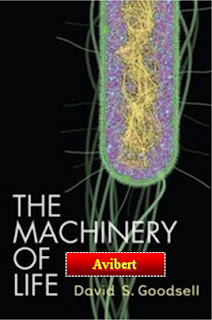
Contents
Chapter 1
Introduction
Chapter 2
Molecular Machines
Chapter 3
The Processes of Living
Chapter 4
Molecules in Cells: Escherichia coli
Chapter 5
A Human Cell: The Advantages of Compartments.
Chapter 6
The Human Body: The Advantages of Specialization
Chapter 7
Life and Death
Chapter 8
Viruses
Chapter 9
You and Your Molecules
Statistical Aspects of
the Microbiological Examination of Foods Basil Jarvis

Contents
Chapter 1
INTRODUCTION
Chapter 2
SOME BASIC STATISTICAL CONCEPTS
Chapter 3
FREQUENCY DISTRIBUTIONS
Chapter 4
THE DISTRIBUTION OF MICROORGANISMS IN FOODS IN RELATION TO SAMPLING
Chapter 5
STATISTICAL ASPECTS OF SAMPLING FOR MICROBIOLOGICAL ANALYSIS
Chapter 6
ERRORS IN THE PREPARATION OF LABORATORY SAMPLES FOR ANALYSIS
Chapter 7
ERRORS ASSOCIATED WITH COLONY COUNT PROCEDURES
Chapter 8
ERRORS ASSOCIATED WITH QUANTAL RESPONSE METHODS
Chapter 9
STATISTICAL CONSIDERATIONS OF OTHER METHODS IN QUANTITATIVE MICROBIOLOGY
Chapter 10
MEASUREMENT UNCERTAINTY IN MICROBIOLOGICAL ANALYSIS
Chapter 11
ESTIMATION OF MEASUREMENT UNCERTAINTY
Chapter 12
STATISTICAL PROCESS CONTROL USING MICROBIOLOGICAL DATA
Chapter 13
VALIDATION OF MICROBIOLOGICAL METHODS FOR FOOD
Chapter 14
RISK ASSESSMENT, FOOD SAFETY OBJECTIVES AND MICROBIOLOGICAL CRITERIA FOR FOODS
The Benchmarking Book A How-to-Guide to Best Practice for Managers and Practitioners
Tim Stapenhurst
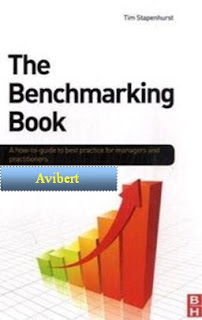
Contents
Part I: A background to BM
1 What is Benchmarking
2 Methods of Benchmarking
Part II: The Benchmarking Process
Introduction and Process Overview
Phase 1: The Benchmarking Process: Internal Preparation
3 Selecting a Project and Commissioning the Team
4 The Team Begins Work: Honing the Project Charter
5 Identifying and Selecting Benchmarking Participants
6 Metrics and Data
7 Normalization: How to Compare Apples with Pears
8 How to Identify Benchmarking Metrics
9 Reviewing and Finalizing Metrics
10 The Importance of Operational Defi nitions and How to Create Them
11 Finalizing the Project Plan and Gaining Management Support
12 Inviting and Working with Participants
Phase 2: The Benchmarking Process – Benchmarking Performances
13 Effective Acquisition of Complete Accurate Data
14 Turning Data into Recommendations: Data Analysis
15 Finalizing the Report and Other Deliverables
Phase 3: The Benchmarking Process–Improving Performance
16 From Report to Improvement: Preparing for Improvement
17 Beyond the Numbers: Gathering Information from Participants
18 Implementation Considerations
19 Copying without Understanding: A Risk Too Far
Part III: Managerial and Organizational Aspects of Benchmarking
20 Management Roles and Responsibilities
21 An Introduction to Legal Issues and Working with Consultants
Part IV: Case Studies
22 Benchmarking IT at Citigroup
23 The Drilling Performance Review – The Evolution of a Benchmarking Club
24 Benchmarking Local Government Services
25 The Best Practice Club
Bibliography
Appendix A1: Data Analysis and Presentation Tools
Appendix A 2 : Querying the Quartile
Nuevos Requisitos de Registro de Alimentos Adulterados FDA

Para cumplir con este nuevo requisito la FDA establecerá un portal electrónico similar al del Registro de Instalaciones Alimenticias bajo la Ley de Bioterrorismo, pero en este caso será para alimentos adulterados. Los alimentos adulterados que se deben denunciar son aquellos alimentos regulados por la FDA que al ser consumidos puedan ser peligrosos para la salud de humanos y animales (incluye alimento animal, goma de mascar y artículos utilizados en la elaboración de comidas).
El dueño, operador, agente o una persona autorizada de una instalación nacional o extranjera que manufactura/procesa, empaca, o almacena alimentos para humanos o animales que van a ser consumidos en los Estados Unidos debe informar si el alimento fue adulterado. Solamente se está exento de presentar un informe cuando se cumple con los siguientes 3 criterios:
1. La adulteración se originó con la parte responsable
2. La parte responsable detectó la adulteración antes de que se transfiera el producto a otra persona de la cadena
3. La parte responsable corrigió la adulteración o destruyó el producto.
Una vez que la empresa recibe un resultado positivo del laboratorio que indica la presencia de algún patógeno en el alimento tiene 24 horas para ingresar la información en el portal de la FDA. Cuando se realiza la denuncia, en el informe inicial se debe incluir información básica relacionada al producto adulterado como la descripción del producto, el alcance y naturaleza de la adulteración, información de la etiqueta para identificar el producto, número de registro del establecimiento (Ley de Bioterrorismo). Una vez finalizado el informe el sistema emite un número de identificación de denuncia. Este número se puede utilizar para ingresar nuevamente al sistema e ingresar información adicional a medida que se encuentra disponible y que pueda ayudar a la FDA a identificar y localizar al producto adulterado en la cadena de comercialización.
A su vez este número de identificación se debe proveer a la parte inmediata anterior y posterior de la cadena de comercialización de dicho producto dado que también están obligadas a presentar el informe a la FDA y a determinar si son causantes de la adulteración del producto, haciendo referencia al mismo número de identificación para poder relacionar los casos. A su vez estas partes responsables deben informar a su parte inmediata anterior y posterior de la cadena de comercialización.
Cabe aclarar que a diferencia del Sistema de Notificación de Rechazos de la FDA (Refusal Notice ) la información ingresada en el portal RFR es privada, solamente tiene acceso a la misma la FDA con el objetivo de evaluar la gravedad del caso y accionar como corresponda.
Como se indicó anteriormente esta nueva regulación entrará en vigencia el 8 de septiembre de 2009, sin embargo la agencia está realizando una serie de seminarios para divulgar la información y recibir sugerencias del público que le permitirán modificar el portal de manera que el proceso sea sencillo. Se puede ver una copia de la guía que publicó la agencia con la información disponible al día de la fecha en: FDA
The Quality Auditor’s HACCP Handbook by ASQ Quality Press
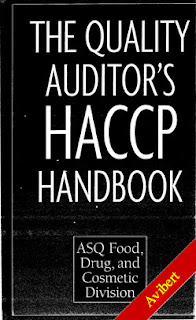
Contents
Part I An Introduction to HACCP
Chapter 1
History and Overview of HACCP: Primitive and Modern Food Preservation Methods
Chapter 2
Tasks for HACCP Plan Development
Part II Principles of HACCP
Chapter 3
Principle #1
Conduct Hazard Analysis
Chapter 4
Principle #2
Determine Critical Control Points
Chapter 5
Principle #3
Establish Critical Limits
Chapter 6
Principle #4
Establish Monitoring Procedures
Chapter 7
Principle #5
Establish Corrective Action Procedures
Chapter 8
Principle #6
Establish Verification Procedures
Chapter 9
Principle #7
Establish Record Keeping and Documentation Procedures
Part III Implementing HACCP
Chapter 10
HACCP Plan Implementation and Maintenance
Part IV Appling HACCP to the Food Processing Industry
Chapter 11
Food Industry in General
Chapter 12
Prerequisite Areas for Food Safety
Chapter 13
Meat and Poultry
Chapter 14
Seafood
Chapter 15
Dairy
Chapter 16
Fruits and Vegetables
Chapter 17
Retail and Food Service
Part V Appling HACCP to the Medical Device Industry
Chapter 18
HACCP Principles in the Design and Manufacture of Medical Devices
Part VI Appendices
Cereal Biotechnology
Food Science and Technology

A pedido de Murci
Contents
Chapter 1
Introduction
Chapter 2
The genetic transformation of wheat and barley
Chapter 3
The genetic transformation of rice and maize
Chapter 4
Product development in cereal biotechnology
Chapter 5
Using biotechnology to add value to cereals
Chapter 6
Molecular biological tools in cereal breeding
Chapter 7
Risk assessment and legislative issues
Chapter 8
Current practice in milling and baking
Chapter 9
Current practice in malting, brewing and distilling
Chapter 10
Current practice in cereal production
Chapter 11
Summary and conclusions
Microbiology Demystified
A Self-Teaching Guide

Contents
CHAPTER 1
The World of the Microorganism
CHAPTER 2
The Chemical Elements of Microorganisms
CHAPTER 3
Observing Microorganisms
CHAPTER 4
Prokaryotic Cells and Eukaryotic Cells
CHAPTER 5
The Chemical Metabolism
CHAPTER 6
Microbial Growth and Controlling Microbial Growth
CHAPTER 7
Microbial Genetics
CHAPTER 8
Recombinant DNA Technology
CHAPTER 9
Classification of Microorganisms
CHAPTER 10
The Prokaryotes: Domains Archaea and Bacteria
CHAPTER 11
The Eukaryotes: Fungi, Algae, Protozoa, and Helminths
CHAPTER 12
Viruses, Viroids, and Prions
CHAPTER 13
Epidemiology and Disease
CHAPTER 14
Immunity
CHAPTER 15
Vaccines and Diagnosing Diseases
CHAPTER 16
Antimicrobial Drugs






















































